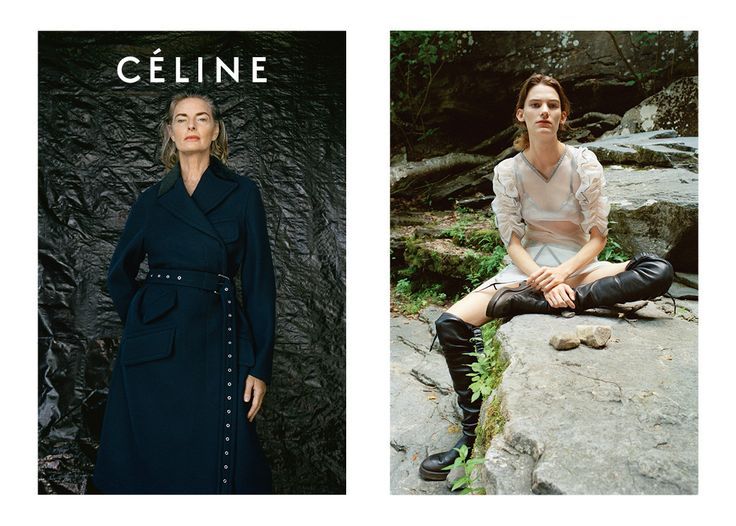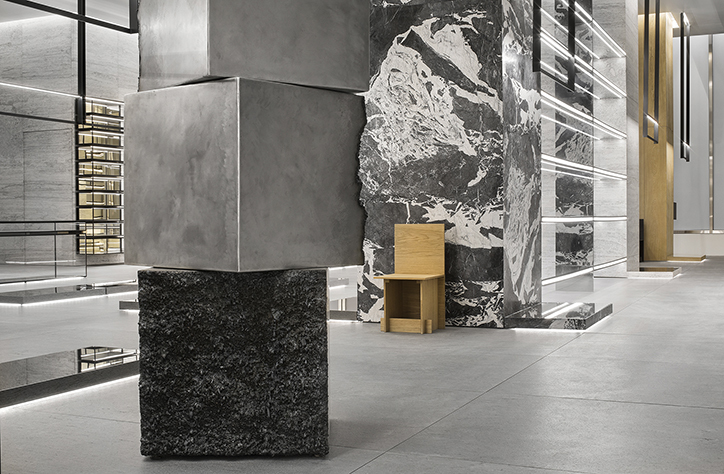As the continual from our discussion of Yves Saint Laurent on shifting identities of brands themselves and of society’s portrayal of dressing oneself, it would be oblivious if Celine did not take part in this potentially controversial yet necessary discussion.
Why controversial? When a designer is to be succeeding a predecessor with a pronounceable-sized shadow, this signifies two things. On the one hand, there is the presence of a strong “fan base” who likely identifies their purchase vision according to this designer’s aesthetics, color palette, design philosophies, etc. On the other hand, to succeed said designer means to either play with the cookie cutters left around, or to throw them all out and make your own molds. This dilemma further complicates when one is not just succeeding a designer in a brand ,but a fashion house. In this case, you are most likely not asked to make your own molds but to reinterpret, modernize, and innovate in avery wide but still, bounded territory. You do not get to just make your own molds because the weight of the founders is what the house stands on, and as a designer walking on these grounds, you have to at least learn to balance.

“Hedi’s wind is blowing”
An article in BoF quoted one of the “Philophiles” on the 29th of September 2018, hours before Slimane debuted his first collection for Celine after Phoebe Philo left the house. However, before we get into arguably the most controversial transition of modern fashion history, let’s take a look at the brand itself.

Céline was founded in 1954 by Céline Vipiana and her husband Richard as a made-to-measure children’s shoe business with a red elephant logo realized by cartoonist Raymont Peynet. Finding success, in 1960 Vipiana took the chance to reposition their business on ready-to-wear fashion brand for women. Advocating practicality, she launched a sportswear driven line, offering loafers, gloves, leather vests, denim, and bags. Later on in the mid 1960s, Céline opened a leather goods factory in Florence then proceeded on redesigning their logo with an intertwined “C”, which associated with the Arc-de-Triomphe of Paris. As Céline began expanding internationally, it caught Bernard Arnault’s attention and soon became acquired and integrated into LVMH for 2.7 billion French francs ($540 million) in 1996.
After the passing of Céline Vipiana in 1997, Michael Kors succeeded as the first and lead designer for women’s ready-to-wear that same year, then creative director in 1999. In 2004, Kors left Céline to focus on namesake label as Italian designer Roberto Menichetti took the helm for merely a year before being replaced by Ivana Omazic. Omazic having worked with Romeo Gigli, Jil Sander, Prada, and Miu Miu still couldn’t quite catapult the brand forward as intend be. In September 2008, WWD announced LVMH’s appointment of Phoebe Philo as the new creative director of Céline, replacing Omazic’s almost 3 years run, later on presenting her first ready-to-wear S/S10 collection for the brand at Paris Fashion Week in 2009.

At this point we arrived to the noteworthy point of transition which made the second Hedi wave felt more deeply than all its previous ones. To fully comprehend how Slimane made such a splash with his succession, one must examine what exactly was he succeeding.
Philo was known as a ‘women’s designer’, “[her] specialness lies in synthesizing how women want to dress with how they actually live their lives… how [they] want to see [themselves]: sophisticated, knowledgeable, not victimized by fashion”. Phoebe designed for women, not a woman.

Under Philo’s directions, Céline’s annual sales went from €200 million to €700 million in a decade (according to analysts as LVMH does not reveal brand-specific details). With her minimalist and extremely chic take on Vipiana’s aesthetics, Philo showed sharp tailoring, precise lines, and fluid shapes with a sophisticated, singular vision, or in her own words “I just thought I’d clean it up…Make it strong and powerful – a kind of contemporary minimalism”. Phoebe’s Céline communicates an understated yet statement-making luxury; she forges her own path independently from what the rest of the industry is or may be up to. Phoebe won the British Designer of the Year at the British Fashion Awards in 2010, then in 2011 the International Award at the CFDA Fashion Awards, both in regards to her works at Céline.
Phoebe refined femininity in Céline, valuing elegance over sex appeal, permissioning sneakers over heels. She showed how fashion’s silhouettes are to be complementing a woman’s lifestyle and not the other way around. On this note, Hedi was not merely succeeding a person but a designer that rewrote brand history by simply “[turning Céline] into a mirror image of herself” (BoF 2014).
On the 21st of January, 2018, splashed across headlines “Hedi Slimane to replace Phoebe Philo at Céline”, starting immediately at the French house on the 1st of February. Slimane’s first act was removing the accent on the e, respacing the brand logo, then proceeded to return to his form: the rock’n’roll, lean, sharp visual vocabulary he always used. On the 28th of September, Hedi sent a collection of “glitzy, party-ready looks” down the runway of Celine, reconfirming that Hedi does Hedi, at Dior, at Saint Laurent, and now again at Celine. A brand that lead feminism was batted flat in the blink of an eye and Philophiles finally accepted that Céline will no longer be around. This seemingly unmendable tear, to many, symbolized the brand no longer designed either for or about women.

Hedi redefined the brand’s identity, customer, all the way down to a 360° transformation on all stores’ internals. A ferocity, constructed with black granite and stainless steel threaded with cream and cedar wood ran across the new Celines’ interiors. As if architectural roughness was brought purposely to contrast the delicate luxuriousness of the clothes. Nevertheless, none of the stores are identical as he arranges every store personally, considering their geographical details and local scenes to have them perfectly incorporated within each community. One may say Hedi’s vision never diverts, but it is undeniable that it takes talent to curate it to perfection… every. single. time. The day after Hedi showed his collection for Celine, Philo fans turned heartbreak into profit; high end luxury sites’ prices spiked 7% in general and clothing pieces’ prices went up as much as 30%; searches for Céline increased 52% during the first month, then 29% the following month. According to BoF, “Between September 27th and October 2nd 2018, visits to Celine pages on Vestiaire increased [by] 275 percent while the number of Celine products sold increased by 43 percent compared to the same time last year”. Moreover, there was at highest a 700% increase for searches of Céline on ebay calculated over a 3-day period after the Hedi show. These statistics speaks self-evidently that this was the Philophiles’ last attempt to keep Phoebe around. How long will this storm last? Who knows. At least what is still available of the old Céline will, hopefully, sustain the hunt until fashion finds another Phoebe to dress this restless and distressed crowd.

The Celine case is very particular in many ways. First and foremost, the brand never properly established itself on the map until Phoebe’s reign. It was rinsed, dyed a new color, and dried then packaged to be offered. It was, in Phoebe’s words, “whatever (she makes) of it” for the time that she was there. Phoebe’s Céline was curated down to every detail. She drafted in permanent markers and her visions were held like bylaws, then further laminated. Philo launched the brand, quite literally, by giving it the identity that Vipiana never truly mapped out. She convinced the world that that wasCéline. On the other side, Hedi Slimane is dubbed a lot of things, but not a follower. After building Dior Homme up from nothing then dropping Yves from YSL, Hedi’s linear vision unapologetically prints his name in bold on all that he touches. When entering Céline, Slimane brought Phoebe’s era to a screeching halt. “You don’t enter a fashion house to imitate the works of your predecessors,” Hedi famously said in his interview before he took over the French house. “All I do is all I am.”

It is still too early to determine where the brand is going. As much as there is a huge cast of Saint Laurent’s shadow, namely with Hedi’s signature embroidered under, we must remind ourselves that it has been merely three collections. With Hedi’s attempt to meet Phoebe half-way at A/W19, then retrieving back to his shell a season later, who’s to say what his intentions really are. LVMH’s unpredictable designer roulette has always left a dubious atmosphere for customers or even houses per se. Will this silent imitation game continue or are designers expected to carve their blueprints in stone, and just stick to that?
Perhaps what Slimane is doing is not to imitate Philo’s aesthetics, but what he mirrors is her unparalleled execution. Hedi is doing Celine as solid as Phoebe did Céline, whatever he makes of it.
We would be kidding ourselves if we said Hedi did not yet once again singlehandedly bring change in an industry that feeds on it. Gracefully? Absolutely not.
by Ashley Kao




